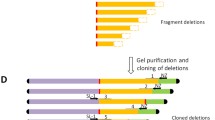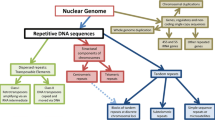Abstract
A long mosaic repetitive sequence (LMRS) was isolated from a mouse liver genome library using a mouse repetitive DNA as a probe. LMRS exhibits the following features: (1) it is almost 15 kb in length; (2) it is partly organized in tandem array and frequently interrupted by other repeated sequences; and (3) it is located predominantly on the A3 band of the mouse X Chromosome (Chr). One fragment of LMRS (B6) shows restriction fragment length polymorphism (RFLP) between different mouse strains, and is thus potentially useful for mapping studies. The nucleotide sequence confirms a mosaic organization of LMRS which includes three repeats in the 5′ part, showing similarity with the 5′ end of L1Md-A2, and seven long A+T rich segments in the central part of the element. Our findings suggest that this sequence may have arisen from the duplication of an ancestral motif and has expanded by successive waves of amplification and invasion by foreign sequences.
Similar content being viewed by others
References
Brown, S.D.M. and Dover, G.A.: Conservation of segmental variants of satellite DNA of Mus musculus in a related species: Mus spretus. Nature 285: 47–49, 1980.
Decoville, M., Malfoy, B., and Locker, D.: Studies of a novel repetitive sequence family in the genome of mice. Eur J Biochem 174: 679–684, 1988.
Disteche, C.M., Gandy, S.L., and Adler, D.A.: Translocation and amplification of an X-chromosome DNA repeat in inbred strains of mice. Nucl Acids Res 15: 4393–4401, 1987.
Horz, W. and Altenburger, W.: Nucleotide sequence of mouse satellite. Nucl Acids Res 9: 683–696, 1981.
Loeb, D.D., Padgett, R.W., Hardies, S.C., Shehee, W.R., Comer, M.B., Edgell, M.H., and Hutchison III, C.A.: The sequence of a large L1Md element reveals a tandemly repeated 5′ end and several features found in retrotransposons. Mol Cell Biol 6: 1561–1571, 1986.
Maniatis, T., Fritsh, E.F., and Sambrook, J.: Molecular Cloning: A Laboratory Manual, Cold Spring Harbor Laboratory Press, New York, 1982.
Miklos, G.L.G.: Localized highly repetitive DNA sequences invertebrate and invertebrate genomes. In R.J. MacIntyre (ed.); Molecular Evolutionary Genetics, pp. 241–321, Plenum Press, New York, 1985.
Nasir, J., Fisher, E.M.C., Brockdorff, N., Disteche, C.M., Lyon, M.F., and Brown, S.D.M.: Unusual molecular characteristics of a repeat sequence island within a Giemsa-positive band on the mouse X chromosome. Proc Natl Acad Sci USA 87: 399–403, 1990.
Rice, N.R. and Strauss, N.A.: Relatedness of mouse satellite deoxyribonucleic acid to deoxyribonucleic acid of various Mus species. Proc Natl Acad Sci USA 70: 3546–3550, 1973.
Sanger, F., Nicklen, S., and Coulson, A.R.: DNA sequencing with chain terminating inhibitors. Proc Natl Acad Sci USA 74: 5463–5467, 1977.
Singer, M.F.: SINEs and LINEs, highly repeated short and long interspersed sequences in mammalian genomes. Cell 28: 433–434, 1982.
Southern, E.M.: Long range periodicities in mouse satellite DNA. J Mol Biol 94: 51–69, 1975.
Viegas-Pequignot, E., Dutrillaux, B., Magdelenat, H., and Coppey-Moisan, M.: Mapping single-copy DNA sequences on human chromosomes by in situ hybridization with biotinylated probes: Enhancement of detection sensitivity by intensified-fluorescence digital-imaging microscopy. Proc Natl Acad Sci USA 86: 582–586, 1989.
Vogt, P.: Potential genetic functions of tandem repeated DNA sequence blocks in the human genome are based on a highly conserved “chromatin folding code.” Hum Genet 84: 301–336, 1990.
Weiner, A.M., Deininger, P.L., and Efstriadis, A.: Nonviral retroposons: Genes, pseudogenes and transposable elements generated by the reverse flow of genetic information. Ann Rev Biochem 55: 631–661, 1986.
Author information
Authors and Affiliations
Additional information
The nucleotide sequence data reported in this paper have been submitted to EMBL and have been assigned the accession number X55036.
Rights and permissions
About this article
Cite this article
Decoville, M., Moreau, P., Viégas-Péquignot, E. et al. Genomic organization and nucleotide sequence of a long mosaic repetitive DNA in the mouse genome. Mammalian Genome 2, 172–185 (1992). https://doi.org/10.1007/BF00302875
Received:
Accepted:
Issue Date:
DOI: https://doi.org/10.1007/BF00302875




